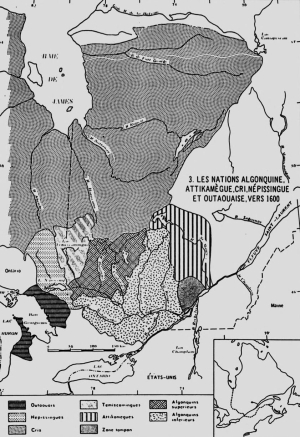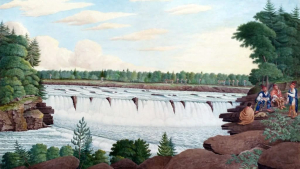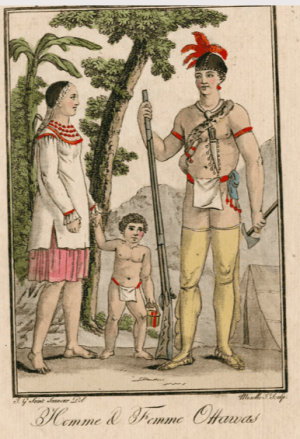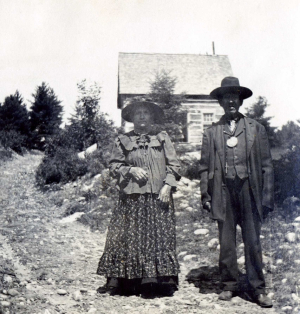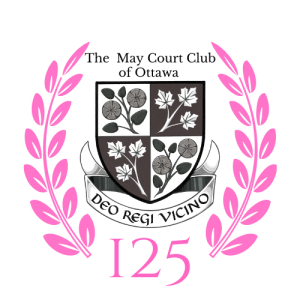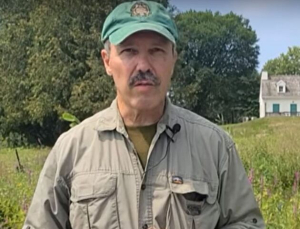“Unceded” Land: Understanding the Historic Land Claims of the Anishinaabe Alqonquin People
When we acknowledge that, here in the Ottawa Valley, we are on the “unceded” and “unsurrendered” land of the Anishinaabe Algonquin people, what does that really mean?
A preliminary understanding of the history behind the land claims of the Anishinaabe Algonquin peopleis offered in a “Report on the Algonquins of Golden Lake Claim” prepared for the Ontario Native Affairs Secretariat in 1993.
The following is the text of the report’s “Executive Summary”.
Here is a link to the full report, residing on the Government of Canada website: https://publications.gc.ca/collections/collection_2018/aanc-inac/R32-492-1993-1-eng.pdf.
This report was authored by Joan Holmes & Associates, Inc. Joan Holmes has a Master’s Degree in Northern and Native Issues from the Institute of Indigenous and Canadian Studies at Carleton University (1983) and over the past 40 years has been widely called upon as an expert in the field of Indigenous land claims and litigation.
REPORT ON THE ALGONQUINS OF GOLDEN LAKE CLAIM
EXECUTIVE SUMMARY
Prepared by Joan Holmes & Associates, Inc. for Ontario Native Affairs Secretariat October 30, 1993
Lynn Gehl – Akikodjiwan
Lynn Gehl, PhD, author, activist and member of the Algonquins of Pikwàkanagàn First Nation, makes the case, in this 2018 article, that historic and current development has betrayed the "Asinabka" vision of the late Chief William Commanda and desecrates what should alternatively be preserved and honoured as our nation's potential "heart of reconciliation":
The Chaudière Falls (Akikodjiwan) and surrounding landscape have long been a sacred place for Algonquin and other First Nations. How has this been impacted over the past two centuries, since the arrival of Europeans in the Ottawa area?
Has the historic and ongoing development of the Chaudière district (Chaudière Falls and Chaudiére, Albert, and Victoria Islands) been emblematic of our nation's disregard for Indigenous rights and jurisdiction?
Akikodjiwan - The Destruction of Canada’s Heart of Reconciliation
Prior to colonization, the Algonquin Anishinaabeg relied on the land and waterways now known as the provinces of Ontario and Quebec and the Ottawa River. Through the gifts they provided, the Algonquin achieved mino-pimadiziwin (the good life).
It was through Nanaboozo’s hardship of living without a father, his process of seeking revenge and learning forgiveness, that human beings understand reconciliation. The Spirit of the West Wind gave the First Sacred Pipe to his son Nanaboozo, instructing him about the rituals of reconciliation that include ceremony and prayer as the practices of reunion between father and son, peoples, and nations.
“During the historic treaty process British officials ignored the Algonquin because our very territory was becoming the heart of Canada.”
While many people think this Nanaboozo story is a romantic belief that lacks rationality, it is much more. Sacred beliefs that value the natural world are far more sustainable and intelligent than the destruction that manifests through the current economic paradigm, resulting in the polluting of our land and waterways with such things as plastic, sewage, chemicals, and radioactive particles.
During the historic treaty process British officials ignored the Algonquin because our very territory was becoming the heart of Canada. Through subjugating the Algonquin, the colonizers were able to appropriate Algonquin territory and centralize their Parliament base.
Many people today think Canada is in a better place with Indigenous nations. This is not so. Through the power gained from pilfering Indigenous land and water rights, Canada continues to divide the Algonquin through practices such as obfuscating and spinning what Canada’s treaty responsibilities are.
“In a world of economic power that lacks an understanding of the importance of preserving what is sacred, Algonquin jurisdiction and human rights continue to be pushed aside.”
Akikodjiwan and Akikpautik (Pipe Bowl Falls), located in the Ottawa River just upstream from Canada’s Parliament, are the very land and waterscapes where Creator placed the First Sacred Pipe. Through colonization Akikpautik was eventually dammed, and the islands that make up the larger Akikodjiwan landscape are now called Chaudière, Albert, and Victoria Islands. It was Grandfather William Commanda’s vision to have this sacred place restored. His Asinabka plan was endorsed and promised by many.
Unfortunately, despite Prime Minister Justin Trudeau’s rhetoric of respecting a “nation-to-nation” relationship and calling for “reconciliation,” the current Liberal government is permitting the further desecration of this sacred place. I offer here a timeline of the continued destruction of the ultimate place of reconciliation inscribed by Creator.
1613: Samuel de Champlain records the Anishinaabeg offering tobacco to Akikpautik (Pipe Bowl Falls), also called Asticou meaning “the boiler.” Champlain translates this as “Chaudière.”
1806: Philemon Wright’s lumber industry begins within Algonquin traditional territory in the Ottawa River Valley.
1854: The Government of the Province of Canada approves an Order-in-Council reserving the Chaudière Islands and adjacent area of the Ontario shoreline for public purposes.
1856: Leases are issued so the lumber industry can harness the water’s energy for their sawmills. These lots are on Chaudière, Albert, and Victoria Islands.
1880: J.R. Booth now holds most of the lease interests on the Islands.
1908: A large ring dam is constructed extending from Chaudière Island over the entire span of the falls. Eventually E.B. Eddy takes over its operation for pulp and paper manufacturing purposes.
1913: William Commanda is born and becomes a respected knowledge holder and Grandfather. Eventually he has a vision about re-naturalizing Chaudière Falls and the Islands. He wants the sacredness of Akikpautik returned to its natural form and the islands housed with a park, an Indigenous centre, and a peace-building meeting site for all peoples. He calls his plan “Asinabka.”
1936: Prime Minister Mackenzie King commissions Jacques Gréber to create a master plan that will govern the development of the National Capital Region.6 It was completed in 1950. Gréber concludes the most effective improvement will be the central park at the Chaudière Falls.
1958: The National Capital Commission (NCC) is established to implement Gréber’s Master Plan.
1969: The NCC purchases 40 per cent of E.B. Eddy’s operations. As a condition the NCC gains first call on E.B. Eddy’s remaining property.
1990: Plans are announced regarding an Indigenous Centre on Victoria Island.
1998: Grandfather Commanda consults with the NCC, Douglas Cardinal, Algonquin communities in the provinces of Ontario and Quebec, and Indigenous and non-Indigenous peoples regarding his Asinabka Plan.
Domtar purchases E.B. Eddy’s operations. This does not mean Domtar purchased the land and waterscape.
2003: Grandfather Commanda asks the NCC and Domtar to produce the deeds to the Islands; nothing materializes.
2004: The Ministry of Canadian Heritage grants Grandfather Commanda $50,000 to further conceptualize his Asinabka Plan.
2006: The NCC endorses Asinabka and allocates $35 million toward it.
Grandfather Commanda prophesizes, “It is a vision for the revitalization of this Sacred Site, Asinabka, at the circular Chaudière Rapids, Akikpautik: The Pipe Bowl Falls.”
Stephen Harper is elected as prime minister and opens the doors for corporate development in respect to the Islands.
2007: Domtar closes their paper mill operation.
2010: The City of Ottawa endorses Grandfather Commanda’s Asinabka Plan.
2011: With great sadness, Grandfather Commanda passes into the spirit world.
2012: Domtar places their interests up for sale. The NCC applies for funds but the treasury board refuses.
Canada permits the transfer of the Ring Dam to Energy Ottawa, a municipally owned power company.
2013: Windmill Development Group publicly announces interest in the Islands, discussing the need for re-zoning for their condominium and commercial development project.
2014: The Circle of All Nations reports that the Service Ontario Land Registry indicates Chaudière Island is not owned by Domtar.
Ottawa City council votes in favour of Windmill’s application to re-zone the islands from “parks and open space” to “downtown mixed use.”
Kitigan Zibi First Nation releases a statement: “Our traditional territory has always been and continues to be, Unceded. We hereby put Canada, Québec and Ontario on notice that [the] status quo, in which our Aboriginal title lands are taken up by governments and industry, is not acceptable.”
Douglas Cardinal, Romola V. Thumbadoo-Trebilcock, Richard Jackman, Larry McDermott, and Lindsay Lambert file an appeal to the Ontario Municipal Board (OMB) regarding the re-zoning.
2015: Windmill re-names their project as “Zibi.”21 Chief Gilbert Whiteduck argues the use of the Algonquin word is cultural appropriation.
May 2015: The City of Ottawa files a motion requesting the OMB dismiss the five appeals regarding the re-zoning due to a lack of planning grounds. This would result in the denial of a full hearing.
June 2015: The OMB pre-hearing begins with member Richard Makuch presiding.
August 2015: The Ottawa Citizen reports that Domtar sells their operations to Windmill. This involves land that Domtar has never proven they own.23 The Service Ontario Land Registry identifies Windmill as leasing the land from Domtar.
The OMB pre-hearing resumes. The appellants argue consultation is required, and that the re-zoning was a departure from the Gréber and Asinabka Plans.
The City and Windmill argue the appellants lack planning grounds, Chaudière Island is no longer an Indigenous cultural site of significance because of the industrial era, and all the land is in private hands. Wolf Lake, Timiskaming, Eagle Village, and Barriere Lake First Nations call for the protection of Akikodjiwan.
November 2015: Makuch dismisses the five appeals on the grounds that the re-zoning conforms to the City’s plan, the appellants failed to raise legitimate planning grounds. He also argues there was adequate consultation with Pikwàkanagàn First Nation and the organization known as the Algonquins of Ontario. In this way he imposes colonial provincial borders on the process of justice thus denying the rights of the larger Algonquin Nation that spans the Ottawa River and includes the Algonquin located in Quebec, both status and non-status Algonquin.
Justin Trudeau is sworn in as prime minister claiming to respect the “nation-to-nation relationship” and genuine “reconciliation.”
The Assembly of the First Nations of Québec and Labrador pass a resolution to protect Akikodjiwan.
Despite Algonquin and settler opposition, Energy Ottawa begins drilling a water channel deep into the bedrock of Chaudière Island27 for additional hydroelectric generation.
March 2016: The appellants appear in the Ontario Divisional Court (ODC) seeking leave to appeal the OMB decision. Justice Charles T. Hackland dismisses them on the grounds the OMB made no errors of law.
June 2016: In protest, more than five hundred people, both settler and Indigenous, walk from Victoria Island to Parliament Hill.
October 2016: Appellants appeal again to the ODC regarding Hackland’s dismissal. A panel of three judges denies the appellants.
December 2017: Although it is said the Tsilhoqot’in decision ushered in a new paradigm regarding Indigenous rights of consent versus consultations, on December 15, 2017, the Government of Canada approved a series of land transfers between the National Capital Commission, Public Services and Procurement Canada, the Ontario Ministry of Natural Resources and Forestry, and Windmill Dream Zibi for lands on islands in the Ottawa River. This happened without the consent of the larger Algonquin Nation, which includes the status and the non-status in both Quebec and Ontario.
February 2018: As of February 5th, 2018 the Service Ontario Land Registry assigns Windmill Dream Zibi Ontario Inc. parcels of land on Chaudière Island and Albert Island.
Contrary to what the City of Ottawa, Windmill Development, and the Ontario Municipal Board argued, the appellants rested their arguments on legitimate planning grounds: Jacques Gréber’s Master Plan and Grandfather William Commanda’s Asinabka Plan.
Both plans long pre-dated Windmill’s project, yet in a world of economic power that lacks an understanding of the importance of preserving what is sacred, Algonquin jurisdiction and human rights continue to be pushed aside. Clearly the Liberal government’s rhetoric of respecting a nation-to-nation relationship and seeking genuine reconciliation is a bold-faced lie.
Author Lynn Gehl © 2018, Lynn Gehl Ph.D. All rights reserved.
(Published in the Watershed Sentinel)
Reprinted with permission of the author.
Lynn Gehl, PhD., is a member of Pikwàkanagàn First Nation. She is the author of two books: 2014’s The Truth That Wampum Tells: My Debwewin on the Algonquin Land Claims Process with Fernwood Publishing; and 2017’s Claiming Anishinaabe: Decolonizing the Human Spirit with the University of Regina Press.
Here is a link to the full article: https://watershedsentinel.ca/articles/akikodjiwan/
Follow this link to view more of Lynn Gehl's work: www.lynngehl.com
Dr. Gehl recommends these resources as further reading:
Matchewan, J-M. (1992, February 4). Algonquin Nation as Represented by Barriere Lake, Kipawa, Timiskaming and Wolf Lake. Retreived from https://publications.gc.ca/collections/collection_2018/aanc-inac/R5-648-1992-eng.pdf
Di Gangi, P. (2018, April 30). Algonquin Territory: Indigenous title to land in the Ottawa Valley is an issue that is yet to be resolved. Canada’s History. Retrieved from https://www.canadashistory.ca/explore/politics-law/algonquin-territory
Dumont, A. (South Wind). (2013, December 28). The Kettle of Boiling Waters: Chaudière Falls, Algonquin Territory. Albert Dumont.Retrieved from http://albertdumont.com/the-kettle-of-boiling-waters-chaudiere-falls-algonquin-territory/
Gehl, L. (2016, November 15). Deeply flawed process around Algonquin land claim agreement. Policy Options.Retrieved from https://policyoptions.irpp.org/magazines/november-2016/deeply-flawed-process-around-algonquin-land-claim-agreement/
Gehl, L. (2018b, March 8). Akikodjiwan: The Destruction of Canada’s Heart of Reconciliation. Watershed Sentinel. Retrieved from https://watershedsentinel.ca/articles/akikodjiwan/
Huitema, M.E. (2000). “Land of Which the Savages Stood in no Particular Need”: Dispossessing the Algonquins of South-Eastern Ontario of Their Lands, 1760-1930 . Master of Arts thesis, Queen’s University, Kingston, ON. Retrieved from https://iportal.usask.ca/record/6234
Jury, E.M. (1966). Tessouat (Besouat); Tessouat (Le Borgne de l’Île); Tessouat (Tesswehas, Le Borgne de l’Île) Paul. Dictionary of Canadian Biography (Vol. 1) (pp. 638-641). Toronto: University of Toronto Press. Here they are online.
- https://www.biographi.ca/en/bio/tessouat_1603_13_1E.html
- https://www.biographi.ca/en/bio/tessouat_1636_1E.html
- https://www.biographi.ca/en/bio/tessouat_1654_1E.html
Matchewan, N. (2008). Blockades: Algonquins of Barriere Lake Defend the Forest, 1989-2008. In First Nations Strategic Bulletin. Volume 6, Issue 1, September – October 2008. (pp. 28-29). Retrieved from https://epe.lac-bac.gc.ca/100/201/300/first_nations_strategic_bulletin/2008/v06n02.pdf
Pasternak, S. (2009, October 26). They’re Clear Cutting Our Way of Life: Algonquins Defend the Forest. Upping the Anti. Retrieved from https://uppingtheanti.org/journal/article/08-theyre-clear-cutting-our-way-of-life/
Pugliese, K. (2005). ‘So, where are you from?’ Glimpsing the history of Ottawa-Gatineau’s Urban Indian Communities. Master’s thesis, Carleton University, Ottawa, ON. Retrieved from https://repository.library.carleton.ca/concern/etds/0v838113m
Sarazin, G (1992). 220 Years of Broken Promises. In B. Richardson (Ed.), Drumbeat: anger and renewal in Indian country (pp. 167-200). Toronto: Summerhill Press. (original work published 1989)
Whiteduck, K. (2009). Our Majestic Forests: An Aboriginal View of Algonquin Park. In D. Euler & M. Wilton (Eds.), Algonquin Park: The Human Impact (pp. 36-54). Espanola, ON: OJ Graphix Inc.
http://www.asinabka.com/geninfo.htm
https://qshare.queensu.ca/Users01/gordond/planningcanadascapital/greber1950/
https://ricochet.media/en/101/ottawa-city-council-approves-rezoning-sacred-algonquin-site
http://rabble.ca/news/2016/06/condominium-development-threatens-protection-algonquin-sacred-site
Jean-Luc Pilon – Paddling through the Past
What vast history existed here in the Ottawa area, long before the establishment of Bytown and the Rideau Canal? Renowned archaeologist/anthropologist Dr. Jean-Luc Pilon helps us reveal our area’s past.
In this episode of the HSO/Rogers TV series, "Time Travelling with the Historical Society of Ottawa", Dr. Jean-Luc Pilon shares "An Archaeologist's Perspective: Uncovering the Ottawa Area's Ancient Past": https://www.historicalsocietyottawa.ca/resources/videos/time-travelling-with-jean-luc-pilon-an-archaeologist-s-perspective-uncovering-the-ottawa-area-s-ancient-past
In this fascinating 45-minute video, “Paddling through the Past”, Dr. Pilon leads us on an inspiring exploration of the clues that are all around us: https://youtu.be/uBUP6OXNd08?si=LT990dWPkTdcEakd
Jim Stone – Chief Pinesi
Much of our nation’s capital today sits specifically on the (unceded) traditional land of Grand Chief Pierre Louis Pinesi and his family.
Jim Stone, a non-Indigenous historian, researched the story of Chief Pinesi in consultation with members of the Algonquins of Pikwakanagan First Nation, where many of Chief Pinesi’s descendants live.
Here is link to the HSO Speaker Series presentation in which Jim spoke about the life and legacy of Chief Pinesi, with introduction and Q&A by Pikwakanagan Band Councillor Merv Sarazin: https://www.historicalsocietyottawa.ca/publications/past-presentations/chief-pinesi-and-his-pursuit-of-justice
In addition, Jim has written a paper about Chief Pinesi presented here: https://kichisibiancienttrails.ca/grand-chief-constant-pinesi/
James Powell – The Anishinabek
James Powell is the author of the blog Today in Ottawa's History giving a day-by-day account of local history.
The Anishinabek
For thousands of years before the Rideau Canal and Bytown, the Ottawa Valley was home to the Anishinaabe Algonquin people and remains their unceded land. James Powell explores the story of the Algonquin people and the devastating impact that European settlement had on their lives and livelihoods: The Anishinabek, Time Immemorial, 7 October 1783
Time Travelling with Jean-Luc Pilon An Archaeologist's Perspective: Uncovering the Ottawa area's ancient past"
Enjoy this episode of the HSO/Rogers TV series Time Travelling with Jean-Luc Pilon.
Going Up the Dumoine
Part One: Pre-Logging
The Kichi Sipi, also known as the Ottawa River, is the thirteenth longest river in Canada. The rivers’ one hundred and forty-six thousand square miles watershed is bisected by the Sibi’s serpentine route as it curls back on itself going west from its source north of Ottawa, then heading southeast from Lake Témiscamingue to the St Lawrence River. It is the traditional unceded territory of the Anishinabe-Algonquin Nation. From the interior, sixteen major tributaries flow from various large headwater lakes to form multiple access routes into the watershed. The only major tributary to have never been dammed, settled, or industrialized save for logging, is the Dumoine. It is now protected as a Quebec aquatic reserve (2008) along with the Coulonge and Noire (2023).
The Kichi Sibi is the watershed that defined the Anishinabe-Algonquin history for time immemorial. Groups of Anishinabe families separately identified themselves as unified self-regulating custodians for ‘their tributary . ’ Together they all formed the Anishinabe-Algonquin Nation. Each family (10-20 related individuals) was assigned approximately a thousand square mile hunting territory, orally defined using natural feature boundaries, and protected by customary law. The Dumoine was a popular route for other nations to cross the Algonquin territory. The Dumoine families, of course, used it frequently to paddle to Algonquin rendezvous for social events. These events were centred on trade, religion, and customary law. The summer wanderings of the families were focused on seasonal harvesting of spawning fish and eels, birds migrating, maturing of fruit, vegetable and medicinal plants, and the gathering of raw materials. These materials were used for creating canoes, hunting and cooking tools, clothing, footwear, dwellings, baskets, and infant cradles. All these goods were often decorated with impressive artwork. The Dumoine group of families, known first to the Jesuits and Champlain as the Otaguottouemin, were identified two centuries later in government documents as the Dumoine Band. Their story is typical of those Algonquins that lived for centuries along the major tributaries.
Long before the Europeans arrived, the Dumoine Band maintained a lifestyle that involved wintering in their designated hunting territories while hunting and trapping. They used the paddling season for travelling throughout the watershed. The chiefs endorsed a few adventuresome individuals to participate in war or trade missions further afield. A wide variety of other First Nations traders brought goods to these families, most often at the trading site at the mouth of the Dumoine. These goods originated from the Mississippi watershed, the Great Lakes, the James Bay, and the Atlantic Ocean, so a variety of food, goods, and cultural ideas penetrated the interior long before the first white man arrived.
The mouth of Dumoine featured a long sandy spit that rose gracefully up into the pine forest as a grass-covered gravel bar capable of growing root crops. It formed a perfect camping and trading site. The Wolf Lake elders (2022), the direct descendants of the Dumoine families, shared with us the name Akonakwasi for this site meaning ‘a long stretch of sand extending far away’ adding Sakik for the mouth and Sibi for the river (now underwater since the Rapides des Joachims dam was built in 1950).
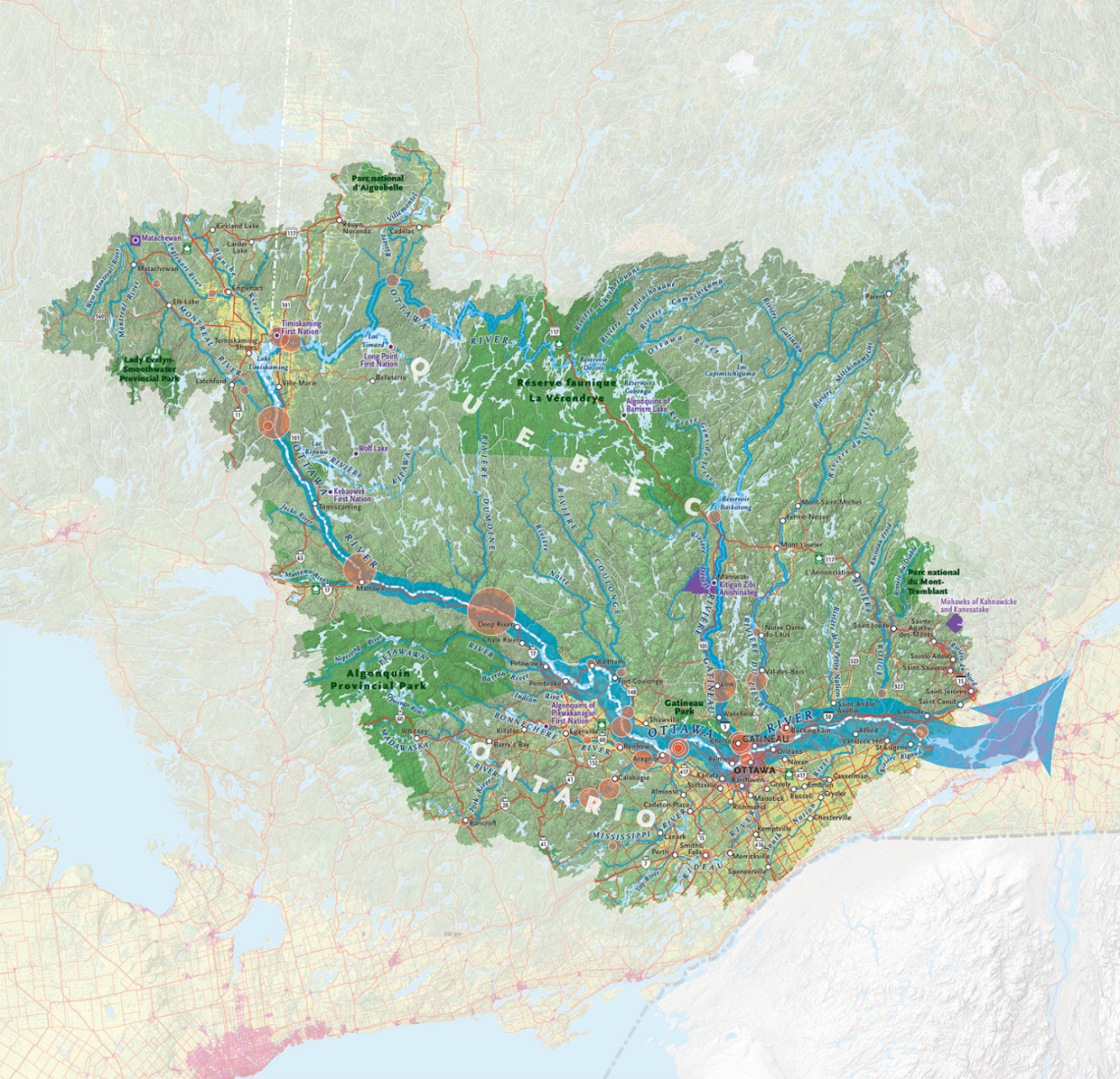 Canadian Geographic map of Ottawa River Watershed.
Canadian Geographic map of Ottawa River Watershed.
It is a challenging four day paddle up the Dumoine which rises one hundred vertical feet as falls, chutes and rapids from the mouth to Lac Dumoine. The creation of magnificent Lac Dumoine is as difficult to imagine being done by a retreating glacier, carving out this eighty-one square mile lake as it is to imagine Nenabojo (also known as Wiske’djak the Anishinabe trickster) chasing a giant beaver out of the south end churning up the land and forming the Dumoine River in the process. But both are accepted stories in different cultures. Lac Dumoine (Anishinabe name is Keewagama one of the many accepted spellings) is unique for four long outlets stretching in each cardinal direction and with a river entering or exiting each. It is a natural traffic circle and has served as an important crossroads for trade and travel since the melting glacier filled it.
French explorer, Samuel de Champlain, was one of the first white men to travel the Kichi Sibi in 1613, preceded by his youthful emissaries Étienne Brûlé and Nicholas de Vignau (1611). Some Anishinabe met white men earlier (i.e. Champlain in Tadoussac in 1603) on their travels outside the watershed. Priests often accompanied Champlain and his emissaries, reflecting that their mission to convert Algonquins (and also exploration) was a priority from France. Champlain himself functioned as both an explorer and soldier, representing New France as an ally of the Algonquins and Hurons against the Iroquois.
Prior to contact with the Europeans, the Algonquin economy had centred on trading furs, dried foods, and hand-crafted products, like birch-bark canoes and other practical implements. After contact, the focus on trade changed to European manufactured goods for furs. From 1620-1700 the Iroquois (Haudensaunee) Confederacy attacked the region of the Kichi Sipi because of their desire to influence the beaver fur trade south to their territory. They sent their warriors north to control the Kichi Sibi trade with attacks originating along many of the major portages along the Ottawa River and as far north as the James Bay height of land. It was tributaries like the Dumoine that provided detours north then east to the French trade centres of Montreal and Trois-Rivières for those trying to avoid the Iroquois. Beginning in 1670 (Royal Charter), the new Hudson's Bay Company was attracting Cree and Anishinabe fur traders north to James Bay. In 1686, to protect the business interests of the merchants of New France, Pierre Le Moyne, Chevalier de Troyes d`Iberville, with the assistance of Anishinabe guides, led French Marines from Montreal up the Ottawa River to attack the British posts on James Bay.
The European trade and the Catholic religion influenced the Dumoine family life by the 1600s. Trade brought metal tools, pots, traps, firearms, woollen blankets and clothing, and other luxuries into the family unit. It also brought disease and alcohol. The Black Robes (Recollects, Jesuits, Sulpicians and finally the Oblates) brought Catholicism to the Algonquins. Being a Catholic (approximately half the Anishinabe population converted) required an annual pilgrimage to the Sulpician mission at Oka near Montreal to be properly baptized, married, or buried as a Catholic. However, beginning in the 1830s, the Oblates built mission churches closer to the Dumoine beside Hudson’s Bay Company posts located at Fort William, Fort Témiscamingue and Fort Grand Lac Victoria, resulting in the elimination of this pilgrimage. The route to the mission at Grand Lac Victoria was up the Dumoine from the Kichi Sibi. Oblate priests, guided by Algonquins may have named the river ‘the river the monks travel.’ This was translated onto maps as Rivière du Moine (Hawkins 1836) and later map makers anglicized this to the Dumoine River.
There were temporary trading posts set up at the Dumoine each spring. Starting with trading posts that independent traders set up in the 1700s, followed by the Northwest Company from 1790-1820, and finally the Hudson’s Bay Company, whose trading posts lasted from 1821 to 1840.
Lumberjacks mixed their French, Irish and English accents together to create the unique phrase for travelling to their new workplace “Going Up da Dumun.” Roderick Ryan was the first lumber baron who used the mouth as a base for his operations for travelling upriver circa 1840. He and John Egan lead an invasion of a new type of economy away from furs and at the expense of the Algonquin Dumoine family way of life. The story of Roderick Ryan and John Egan will be shared in Part Two this blog.
Wallace A Schaber
I am not a professional historian or Anishinabe expert. I am a collector of maps, stories, and artifacts about the Dumoine based on fifty years of guiding there by canoe, ski, and foot. Many of these stories are found in my book, Last of the Wild Rivers (2016), which is out of print but available as an e-book online.
Friends of the Dumoine
In 2016, concerned Dumoine guides and travellers formed Friends of Dumoine to keep the rivers portages and campsites clean.
Mission Statement
“To champion conservation of the Dumoine watershed, promote non- mechanized recreation and strengthen knowledge of its natural environment and human history.”
Our major achievement to date is the re-opening and interpretation of the old Anishinabe portages that existed for centuries and linking them to the Dumoine tote road used by the lumber industry beginning in 1840. This hiking trail is now open from the Ottawa River to Grande Chute as a twenty-six kilometre hiking-skiing trail www.sentierdumoine.ca. A visitor centre at Grande Chute complete with historic maps and artifacts is located at the northern gateway.
Please join us on the trail or virtually online to explore Canada's history and protect it. For more information about how to volunteer or donate write This email address is being protected from spambots. You need JavaScript enabled to view it..
Friends of the Dumoine would like to thank our partners in helping to make this project a reality.
CPAWS Ottawa Valley
ZEC Dumoine
Wolf Lake First Nation
References and Further Reading
Fournier, J-L. Anishinabe Place Names for the Dumoine Hiking Trail, confirmed and sanctioned by Wolf Lake First Nation, May 2022. Prepared for Friends of Dumoine Trail Map published 2024.
Morrison, James. “Algonquin History in the Ottawa River Watershed.” Sicani Research & Advisory Services Ottawa, Ontario, Revised 2005.
Frank G. Speck. “Myths and Folklore of the Timiskaming Algonquin and the Timagami Ojibwa.” Canada Department of Mines. Geological Survey, Memoir 71, No 9 Anthropological Series. Ottawa: Government Printing Bureau, (1915):1-3.
The May Court Club of Ottawa Celebrates 125 Years & The Bytown Museum Opens for the 2023 Season
Our final in-person speaker session of the year, hosted by the Main Branch of the Ottawa Public Library on May 10th 2023, featured presentations from two organizations with whom we have some past connections.
Grant Vogl has been with the Bytown Museum since 2010 and is now the Senior Manager, Collections and Exhibitions. He spoke to us about the changes that have taken place at the museum over the last couple of years and their upcoming season.
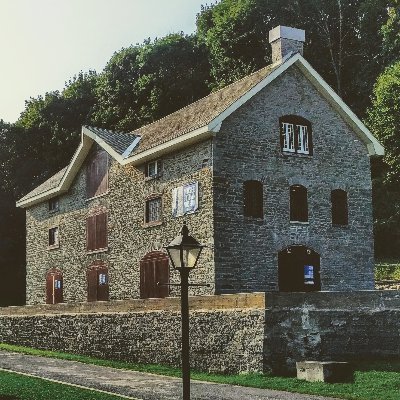 Bytown Museum Grant explained that, like most organizations, the pandemic disrupted the plans of the Bytown Museum. Closed for their 2020 and 2021 seasons, they opened for a shortened 7 week season in 2022 and were pleased to welcome some 12,000 visitors to the museum. They are very excited to be opening this Friday, May 12, 2023 for a full season. Though mostly out of the public view, much was done behind those closed doors. Grant described the work undertaken by the museum toward Reconciliation. Working with the Algonquin communities of Kigitan Zibi and Pikwakanagan, the museum reviewed their exhibits to ensure that Indigenous perspectives are included. It is important to the museum that visitors with an Indigenous heritage see themselves, their symbols, their culture and their language represented in the displays. As such, the museum has a new mural created by Indigenous artists and has 31 new tri-lingual information panels carrying English, French, and Algonquin language explanations.
Bytown Museum Grant explained that, like most organizations, the pandemic disrupted the plans of the Bytown Museum. Closed for their 2020 and 2021 seasons, they opened for a shortened 7 week season in 2022 and were pleased to welcome some 12,000 visitors to the museum. They are very excited to be opening this Friday, May 12, 2023 for a full season. Though mostly out of the public view, much was done behind those closed doors. Grant described the work undertaken by the museum toward Reconciliation. Working with the Algonquin communities of Kigitan Zibi and Pikwakanagan, the museum reviewed their exhibits to ensure that Indigenous perspectives are included. It is important to the museum that visitors with an Indigenous heritage see themselves, their symbols, their culture and their language represented in the displays. As such, the museum has a new mural created by Indigenous artists and has 31 new tri-lingual information panels carrying English, French, and Algonquin language explanations.
Grant also gave us a “sneak peak” into their 2023 season. The Community Gallery hosts an exhibit by artists Gary Blundell and Victoria Ward entitled “Sourcing the Canal”. The exhibit highlights the natural and human landscapes that have been created by resource development whose resources would very likely have travelled through the Ottawa River and the canal. The temporary gallery features an exhibit entitled “City in Flames: Ten Fires that (Re)shaped Ottawa “. Grant explained that Ottawa’s history and landscape have been shaped and re-shaped by fire. Prominent buildings, industrial areas, landmark businesses, homes, and indeed entire neighbourhoods have all fallen victim to flames. These destructive fires not only devastated, but also renewed, allowing for architectural growth, the evolution of the cityscape, new iconic tourism locales, the passing of new laws, and more.
The Bytown Museum and the Historical Society of Ottawa share a common ancestry, both starting by the Women’s Canadian Historical Society of Ottawa. Grant reminded us that the Bytown Museum still recognises this shared heritage by offering free admission to Historical Society of Ottawa members.
To learn more about the Bytown Museum and their 2023 season, please visit their website: bytownmuseum.ca.
We were then pleased to be joined by Donna Shields-Poë, the President of the May Court Club of Ottawa, who introduced their Past President, Nancy Pyper. Nancy is one of those who has spent her life volunteering at whatever was needed, where ever she was, having been almost everywhere across the country as a military wife. She joined the May Court Club of Ottawa in 2013 and soon found herself drafted into leadership roles with them. She started her talk by giving us some background on their founder.
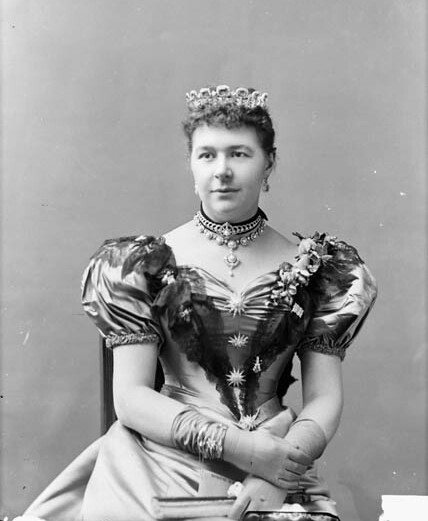 Lady Aberdeen (née Ishbel Marjorbanks) - Topley Studio / Library and Archives Canada / PA-025771Ishbel Maria Hamilton-Gordon, Marchioness of Aberdeen and Temair, GBE, was a truly remarkable person. She had been a social activist in England and Scotland promoting education, health care and women’s suffrage. So when Lady Aberdeen, who also became the Patron to the WCHSO, came to Canada in 1893 as the wife of the Governor-General and discovered that there was no social safety net or supports for women, founded the National Council of Women of Canada, the Victorian Order of Nurses and on April 30, 1898, held an elaborate garden party at Rideau Hall to which she invited young women of prominent families and challenged them to use their time and skills to provide service to those less fortunate. Thus a May Queen was crowned, her Court established, becoming the May Court Club of Ottawa, the oldest women’s service club in Canada. The May Court Club of Ottawa is one of nine now operating in Ontario.
Lady Aberdeen (née Ishbel Marjorbanks) - Topley Studio / Library and Archives Canada / PA-025771Ishbel Maria Hamilton-Gordon, Marchioness of Aberdeen and Temair, GBE, was a truly remarkable person. She had been a social activist in England and Scotland promoting education, health care and women’s suffrage. So when Lady Aberdeen, who also became the Patron to the WCHSO, came to Canada in 1893 as the wife of the Governor-General and discovered that there was no social safety net or supports for women, founded the National Council of Women of Canada, the Victorian Order of Nurses and on April 30, 1898, held an elaborate garden party at Rideau Hall to which she invited young women of prominent families and challenged them to use their time and skills to provide service to those less fortunate. Thus a May Queen was crowned, her Court established, becoming the May Court Club of Ottawa, the oldest women’s service club in Canada. The May Court Club of Ottawa is one of nine now operating in Ontario.
Lady Aberdeen’s call to the young ladies of leisure to do good works was taken up then and has been equally well responded to by subsequent generations of Ottawa women. Nancy shared that there has been a transition, as the world has changed, from single women, an initial requirement for membership, to (still only) women who are now mainly retired. This has in no way dampened their enthusiasm or commitment, their most senior member, now with 66 years of service to our community, at age 93, still does her weekly shift in the Bargain Box nearly-new store. Their motto, “Enriching the lives of others as well as our own”, is clearly heartfelt and heeded.
Nancy explained that the Club has always focused their services on women, children, and the disabled and told us some of what they have done in their century and a quarter of service to the families of Ottawa. These include support to the Victorian Order of Nurses, help in and funding for hospitals, creation of an early lending library for hospital patients (now at the Civic Campus but still closed due to Covid), help to the Red Cross, operation of one of the first (1905) Tuberculosis clinics and the creation, expansion, and operation of a Convalescence Home. Doing things “The May Court way” has allowed the Club to continue to support the families in our city and the many new Canadians who now make their homes with us.
Knitting has always been a major activity of the May Court Club. Nancy told us that this continues today with items being made for sale at artisan festivals, or items such as tuques for preemies or hats for cancer patients made and given as needed. She said that during the two World Wars the Club knitted thousands of pairs of socks for our soldiers, sailors and airmen, as well as cutting fabric and doing much other work for the war effort.
Nancy explained that some confusion exists in the mind of the public between “The May Court Club of Ottawa” and “The Hospice at May Court”. When the Club closed their Convalescents Home, in 1997 after 80 years of operation, they looked for another use for their building. The outcome was a partnership between the Club and All Saints, (now Hospice Care Ottawa); the Club provides the building, looks after maintenance etc. and makes an annual donation of $100,000, but does not actually operate the Hospice. Club members do, however, volunteer their time providing some administrative and other support services.
Traditionally, with the exception of the two World Wars, the Club funded their activities through balls, galas, vaudeville shows and other social events, which were attended by Ottawa’s leading citizens. Times change and now the Bargain Box, which has been open on Laurier Avenue East for 50 years, is the major source of their funds. It survived all the closures and restrictions of the pandemic and is well supported by the local community, especially the students at the University of Ottawa, who appreciate the quality and love the prices.
Like HSO, the May Court Club of Ottawa is celebrating their 125th anniversary this spring. To mark the occasion the Club has just announced a donation of $125,000 to the Crossroads Children’s Mental Health Centre. A wonderful gift from an organization that has certainly more than net the challenge laid down to them by Lady Aberdeen all those years ago.
To learn more about the May Court Club of Ottawa, please visit their Facebook page at maycourtclubottawa or their website at maycourt.org.
Uncovering Our Region’s Ancient Past
The Historical Society of Ottawa was honoured to welcome back Dr. Jean-Luc Pilon as the featured speaker at the April 12, 2023, speaker series session, hosted by the Main Branch of the Ottawa Public Library. Dr. Pilon is a renowned archeologist, long-time curator of Central Canada archaeology at the Canadian Museum of History, an educator, and was the first recipient of the J.V. Wright Lifetime Achievement Award from the Ontario Archaeological Society.
Dr. Pilon, who had spoken to us in November 2016, led us through some of the history of archeological activities in the Ottawa area along with the views of some individuals, organizations and governments. He pointed out that Europeans immediately grasped the importance of this location, Champlain making note of it in his journal in 1613. A Royal Proclamation of 1763 offered a degree of protection to Indigenous lands west of the Appalachian Mountains, but land grants from the Crown and later questionable Crown treaties and purchases, such as the Rideau Purchase of 1819, served to strip the Indigenous peoples of their land and heritage. Philemon Wright noted the objection of the local Indigenous population as he expanded his own enterprises in the area in the early 1800s, especially logging in support of the Napoleonic Wars. Later, about 1843, Dr. Edward van Courtland, a local medical doctor, naturalist and archeologist, identified a major ceremonial and burial site in the area, collecting many artifacts from his find. Archeology, at that time, had little concept of context and would from today’s perspective be more closely associated with looting than science. In describing the site, Dr. Courtland failed to mention on which side of the Ottawa River it fell, leading to a misunderstanding about the location of his discovery that was to endure and propagate for over 170 years. Writing for the Women’s Canadian Historical Society of Ottawa in 1901, Gertrude Kenny provided an anecdotal account of the Indigenous culture that had existed in the area for hundreds of years, but provided no sources for her account. Dr. Pilon noted many others who found artifacts or provided their own interpretations.
Dr. Pilon described how the artifacts flowed to and through a series of museums including the Bytown Mechanics Institute, the Literary and Scientific Society of Ottawa, the Geological Survey of Canada, and now the Canadian Museum of History. The artifacts that have been collected in the valleys of the Ottawa and Rideau rivers have a story to tell. Implements of stone quarried from deposits in Labrador, the Hudson Bay / James Bay and New York State areas, copper from west of Lake Superior, pottery of the Middle Woodland period, virtually identical to that found in the Lake of the Woods area, speak to a broad-based and sophisticated trading network with a critical hub in the Ottawa / Gatineau area that had been active for more than 4,500 years before the arrival of European settlers. The meeting of the Gatineau, Rideau, and Ottawa rivers made this an ideal location for the exchange of goods and ideas, while the presence of the Chaudière Falls, also known as Akikodjiwan, made this a significant spiritual location as well.
During excavations associated with the renovation of the Centre Block of the Parliament Buildings, a stone knife, dated between 2,500 and 4,000 years old was discovered. The knife has been returned to the stewardship of the Algonquin Anishinabe peoples and it is expected that it will be displayed in the Center Block when it reopens.
Dr. Pilon reminded us that as we think about our city, we must remember that this was a center of commerce and culture for thousands of years before anything we see today.
Following Dr. Pilon’s presentation, we were privileged to be joined by several students from Anishinàbe Odjìbikan. Anishinàbe Odjìbikan is an Indigenous Archaeological Field School that provides First Nations students from Pikwakanagan and Kitigan Zibi the phenomenal opportunity to take part in archaeological digs along the shorelines and uncover and better understand their own ancestral past. Jenna and Kyle gave us some background to their program,. Planned in 2019, it, like most things, was delayed by Covid. In 2021, 8 students, 4 from each community participated, while in 2022, 16 students, 10 from Kitigan Zibi and 6 from Pikwakanagan took part. Their hope is to continue the program for at least another three years. The program has strong support from the communities, financial support from the federal government and archeological mentoring from the National Capital Commission. It is hoped that some financial independence can be achieved through access to bid on government contracts.
Jenna and Kyle explained some of the differences between their approach and that of traditional archeology, which has largely ignored First Nation’s voices and their traditional knowledge. They explained that while recovering their own people’s artifacts, they adopt appropriate cultural practices, such as ceremonies to thank the land for its care of the items before and after their recovery and the renewed use of the recovered items as they had been originally intended. In recovering the artifacts, the students and their communities recognize that they are also recovering their own heritage, allowing them their own interpretation not one from a colonial perspective. These artifacts also provide an undeniable proof of the occupation of this land by indigenous peoples for thousands of years before the arrival of the first colonists.
Jenna and Kyle expressed the urgency of their undertaking. Climate change, high water levels and urbanization are damaging and destroying potential sites. They see this program as critical in providing the skills and trained individuals needed to perform the work ahead.
Following their presentation, the students displayed a number of the artifacts they had uncovered and responded to many questions posed by audience members who came down to the stage for a closer look and a chat.
This in-person session, the most popular this season with over 90 people attending, left all of us with a thirst to learn more about the earlier history of the land on which we live and the peoples to whom it belongs.
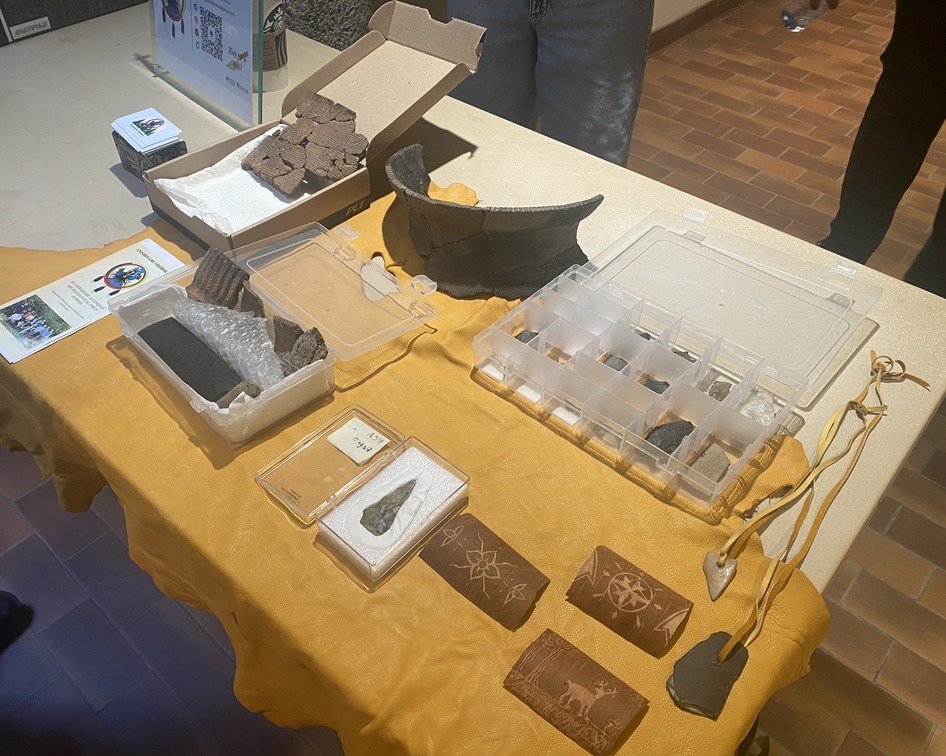 Artifacts presented by Anishinàbe Odjìbikan.
Artifacts presented by Anishinàbe Odjìbikan.
Dr. Jean-Luc Pilon has shared this excellent video, a guided tour as he explores the heart of our region: Paddling through the past - Ottawa-Gatineau's Ancient Cultural Landscape.
Our Acknowledgement
For thousands of years before colonial times, the members of Indigenous communities travelled from far and wide to gather at the meeting of the three rivers: the Ottawa, the Gatineau, and the Rideau; from the Chaudière Falls to the mouth of the Gatineau River.
This area is rich in natural resources — plants, animals, and fish, and also provided a convenient meeting place for trade and communication among communities.
Of special significance are the burial place at Hull Landing and the Chaudière Falls, a sacred place for meeting and sharing in ceremonies.
The burial grounds in the Ottawa-Gatineau corridor including Hull Landing were important for rituals of respect and bonding with the landscape. Victoria Island, located under the Portage Bridge, continues to provide this sacred space to local and visiting Indigenous people.
The National Capital Region, which includes the city of Ottawa, remains unceded Algonquin-Anishnaabeg territory.
We encourage our members and guests to reflect on this, our connected history, and ways we can contribute to reconciliation.
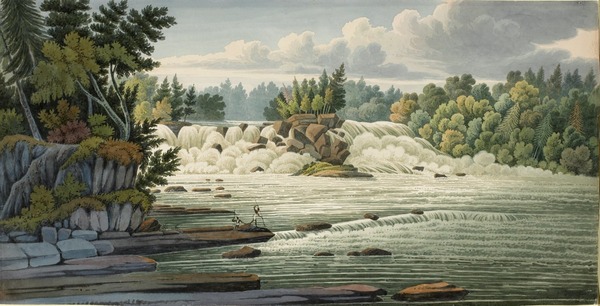 Charles Ramus Forrest Chat Falls, Lake Chaudière on the Ottawa 1822
Charles Ramus Forrest Chat Falls, Lake Chaudière on the Ottawa 1822
Source: HSO Member Margaret Back’s summary of Canadian Museum of History Archeologist (retired) Jean-Luc Pilon’s April 2017 presentation to our Society.



